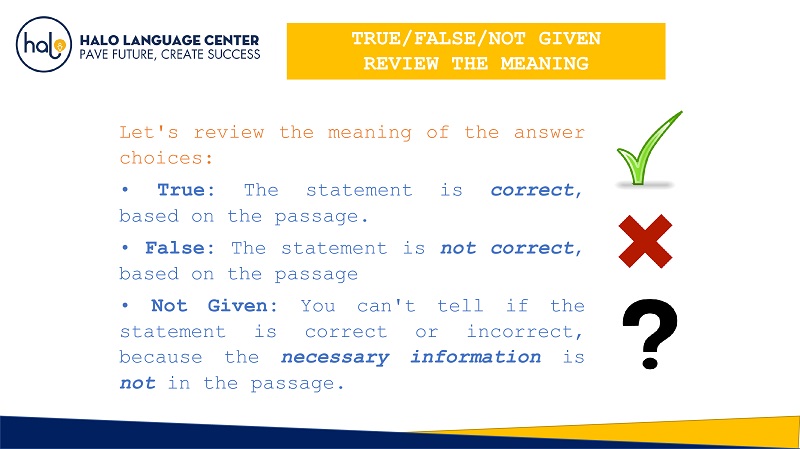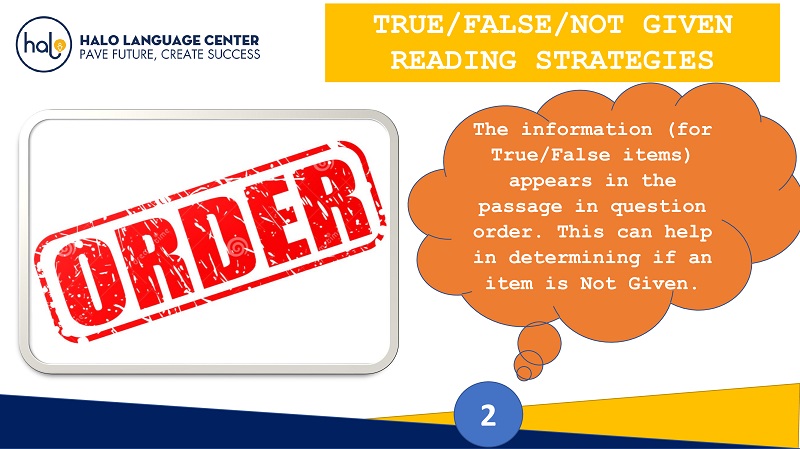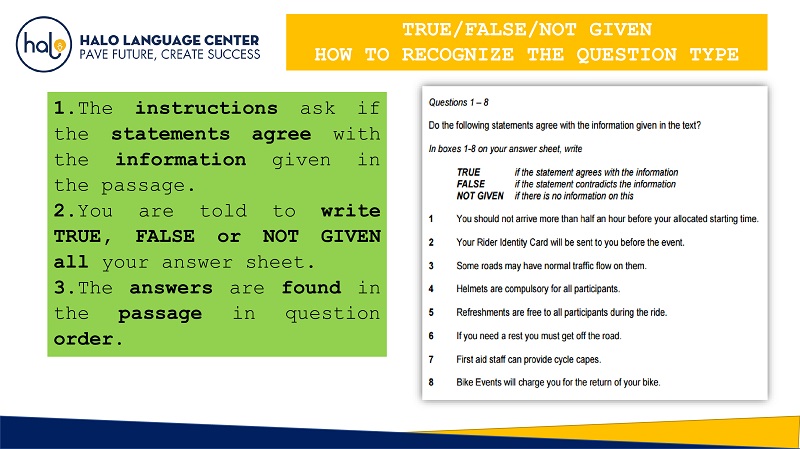Chiến thuật làm bài IELTS, Tự Học IELTS
IELTS Reading True False Not Given
IELTS Reading True False Not Given là dạng bài yêu cầu bạn xác định tính chính xác của các thông tin được đưa ra dựa trên nội dung bài đọc. Dạng bài này đòi hỏi thí sinh phải có khả năng đọc hiểu tốt, kỹ năng skimming và scanning hiệu quả, cũng như khả năng phân biệt thông tin chính xác và thông tin sai lệch. Cùng Halo tham khảo bài mẫu chi tiết bên dưới nhé
I. True/False/Not Given Reading Strategies
1. Understand the meaning of True, False and Not Given.

True/false/not given Review the meaning
Let’s review the meaning of the answer choices:
– True: The statement is correct, based on the passage.
– False: The statement is not correct, based on the passage
– Not Given: You can’t tell if the statement is correct or incorrect, because the necessary information is not in the passage

2. The information (for True/False items) appears in the passage in question order. This can help in determining if an item is Not Given.

3. Identify keywords from each question, and scan for these keywords in the passage.

II. True/false/not given How to recognize the question type
1.The instructions ask if the statements agree with the information given in the passage.
2.You are told to write TRUE, FALSE or NOT GIVEN all your answer sheet.
3.The answers are found in the passage in question order.

III. True/false/not given Getting ready to read
Draw a line matching up the word or phrase on the left with the word or phrase on the right that has almost the same meaning. Take 2 minutes to complete this task.
The goal is to get good at guessing synonyms and paraphrasing, so don’t use a dictionary to help you with your choices. You won’t be able to use one on the day of the test!
B. affect
C. fascinating outcomes
D. laptops, mobiles and tablets
E. described
F. very troublesome
G. tricks our biological systems
H. accelerating
I. contents
J. very thought-provoking
K. decent
L. a greater chance
1. characterised
2. interesting results
3. extremely worrying
4. an Increased likelihood
5. impact
6. speeding up
7. adequate
8. before bed
9. electronic devices
10. subject matter
11. highly mentally stimulating
12. fools the body

IV. IELTS reading True/false/not given Sample task
BLUEBELLS IN BRITAIN
Every April and May, Britain welcomes spring with the blooming of bluebells, which appear in patches large and small across the nation. Indeed, almost half of all native British bluebells (Hyacinthoides non-scripta) worldwide are found in the UK. These bluebells, with their distinctive scent and colour, thrive in the damp habitat of British woodlands.
However, the British bluebell is at risk of extinction, and nowhere more than in London specifically and Southeast England generally, from a Spanish invasion. The Spanish bluebell (Hyacinthoides hispanica) has spread quickly through British cities in the last few decades, to the point where virtually all bluebells in London are hybrids (Hyacinthoides massartiana) of the two varieties.
Hybridisation is a threat to our native bluebells not only in terms of the sheer number of hybrid flowers in our cities, but also in their appearance, which is very difficult to distinguish from those of the unmixed species, except just after the flowers have opened. At this time, native bluebells will have a distinctively sweet scent, with white pollen and stems leaning to one side; the petals are always a notably deep shade of blue-violet.
Compare this to the Spanish bluebell, which features blue pollen and usually stands upright, with petals ranging in colour from blue to pink to white (but never dark blue). A hybrid of British and Spanish bluebells can combine any features of the two, including colour, with one exception: whilst the petals of hybrids can be dark blue, they can never be the blue-violet of the UK species.
There is some good news for British bluebells: they continue to dominate non-native bluebells by a rate of 100-to-1 nationwide, as the Spanish variety does not grow well in woodland, limiting the risk of hybridisation to urban areas. We should not be complacent, though, as botanists agree that the hybrid bluebell is more common than the Spanish species; thus, it’s likely that before long, without intervention, most bluebells in UK cities will show signs of hybridisation.
Questions 1-8
TRUE: if the statement agrees with the information
FALSE: if the statement contradicts the information
NOT GIVEN: if there is no information on this
Do the following statements agree with the information given in the reading passage?
1. Bluebells bloom in Britain in the springtime.
2. Half of all bluebells in the world are found in the UK.
3. British bluebells grow only in woodland.
4. In a few years, the British bluebell will be extinct.
5. Most bluebells in London are Spanish bluebells.
6. Spanish bluebells do not have a distinctive scent.
7. A hybrid bluebell could have white pollen and pink petals.
8. Most hybrid bluebells in the UK are found in forests.
Kết luận
Halo tin rằng với sự chuẩn bị kỹ lưỡng và luyện tập chăm chỉ, bạn hoàn toàn có thể nâng cao điểm số phần IELTS Reading. Hãy theo dõi Halo Language Center để cập nhật mọi tin tức mới nhất về kỳ thi IELTS nhé!


